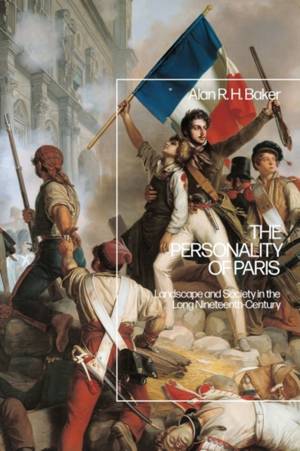
- Afhalen na 1 uur in een winkel met voorraad
- Gratis thuislevering in België vanaf € 30
- Ruim aanbod met 7 miljoen producten
- Afhalen na 1 uur in een winkel met voorraad
- Gratis thuislevering in België vanaf € 30
- Ruim aanbod met 7 miljoen producten
Zoeken
The Personality of Paris
Landscape and Society in the Long-Nineteenth Century
Alan R H Baker
Paperback | Engels
€ 67,95
+ 135 punten
Omschrijving
What was the personality of 19th-century Paris? To answer that question, this book eschews the conventional narrative and chronological route taken by most histories of Paris. Instead, it thematically analyses the complex personality traits of Paris from the onset of the Revolution of 1789 to the beginning of the Great War.
Starting with the topographical and cultural legacies that late 18th-century Paris inherited from its foundation in pre-Roman and Roman times and from its medieval infancy and early-modern adolescence, The Personality of Paris unpacks the social and material complexity of the 19th-century city. It considers the role of immigration in the making of Parisians and in the city's growth from half a million in 1801 to almost three million in 1911. It examines the making of its distinctive landscape through the construction of monuments and architectural icons, through its massive re-modelling by Napoléon III and Baron Haussmann, through its five world exhibitions, through its emphasis on food, fashion and leisure, and through the ways in which Parisians sought rural release from urban pressure. Finally, the book considers the self-harm done to the person of 19th-century Paris by revolutions and wars and the damage inflicted on it by 20th-century hubristic politicians and architects.
Starting with the topographical and cultural legacies that late 18th-century Paris inherited from its foundation in pre-Roman and Roman times and from its medieval infancy and early-modern adolescence, The Personality of Paris unpacks the social and material complexity of the 19th-century city. It considers the role of immigration in the making of Parisians and in the city's growth from half a million in 1801 to almost three million in 1911. It examines the making of its distinctive landscape through the construction of monuments and architectural icons, through its massive re-modelling by Napoléon III and Baron Haussmann, through its five world exhibitions, through its emphasis on food, fashion and leisure, and through the ways in which Parisians sought rural release from urban pressure. Finally, the book considers the self-harm done to the person of 19th-century Paris by revolutions and wars and the damage inflicted on it by 20th-century hubristic politicians and architects.
Specificaties
Betrokkenen
- Auteur(s):
- Uitgeverij:
Inhoud
- Aantal bladzijden:
- 248
- Taal:
- Engels
Eigenschappen
- Productcode (EAN):
- 9781350252639
- Verschijningsdatum:
- 24/08/2023
- Uitvoering:
- Paperback
- Formaat:
- Trade paperback (VS)
- Afmetingen:
- 156 mm x 234 mm
- Gewicht:
- 367 g

Alleen bij Standaard Boekhandel
+ 135 punten op je klantenkaart van Standaard Boekhandel
Beoordelingen
We publiceren alleen reviews die voldoen aan de voorwaarden voor reviews. Bekijk onze voorwaarden voor reviews.











